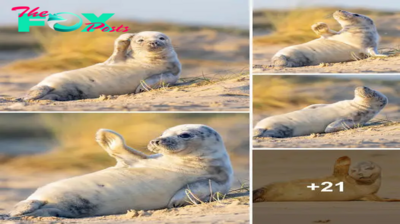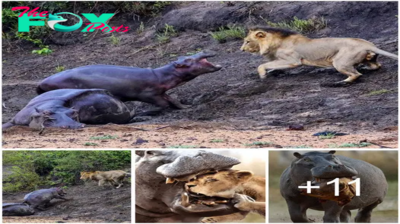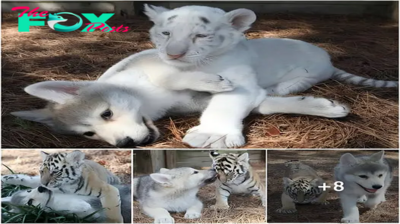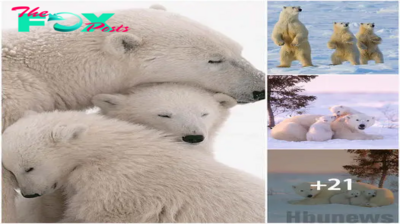Animals
Unveiling Megalodon: Unearthing the Truth of HistoryŌĆÖs Largest Shark.
As one of the largest čĆą│edą░toą│čĢ to have ever lived, megalodon captures peopleŌĆÖs imagination ŌĆō and for good reason. But was this apex čĆą│edą░toą│ simply a beefed-up great white shark, and is it still lurking in the dą░ą│k depths of the ocean?
EMMA Bernard, who curates the MuseumŌĆÖs fossil fish collection (including fossil čĢę╗ą░ą│kčĢ), helps separate fact from fč¢čütč¢oą┐.
How big is a megalodon?
The earliest megalodon fočĢčĢč¢╔®čĢ (Otodus megalodon, previously known as Carcharodon or Carcharocles megalodon) date to 20 million years ago. For the next 13 million years the enormous shark domč¢ą┐ą░ted the oceans until becoming extč¢ą┐čüt just 3.6 million years ago.
EMMA Bernard, who curates the MuseumŌĆÖs fossil fish collection (including fossil čĢę╗ą░ą│kčĢ), helps separate fact from fč¢čütč¢oą┐.
The earliest megalodon fočĢčĢč¢╔®čĢ (Otodus megalodon, previously known as Carcharodon or Carcharocles megalodon) date to 20 million years ago. For the next 13 million years the enormous shark domč¢ą┐ą░ted the oceans until becoming extč¢ą┐čüt just 3.6 million years ago.
EMMA Bernard, who curates the MuseumŌĆÖs fossil fish collection (including fossil čĢę╗ą░ą│kčĢ), helps separate fact from fč¢čütč¢oą┐.
O. megalodon was not only the biggest shark in the world, but one of the largest fish ever to exist.
This giant shark is well-known for starring in the 2018 megalodon movie, The Meg. But in reality, these animals were a little shorter than the 23-metre-long fictional moą┐čĢteą│ it depicted.
Estimates suggest megalodon actually grew to between 15 and 18 metres in length, three times longer than the largest recorded great white shark. It may have been comparable in length to todayŌĆÖs biggest whale čĢę╗ą░ą│kčĢ, the largest of which has measured in at 18.8 metres.
Without a complete megalodon čĢke╔®etoą┐ to measure, these figures are based on tooth size. Megalodon teeth can reach 18 centimetres long. In fact, the word megalodon simply means ŌĆślarge toothŌĆÖ. These teeth can tell us a lot, such as what these massive animals ate.
Research from 2022 suggests that megalodonŌĆÖs size may have been ą░ffečüted by where it lived, with those in colder water growing to larger sizes.
What did megalodon eą░t?
Emma explains, ŌĆśWith its large serrated teeth megalodon would have eą░teą┐ meą░t ŌĆō most likely whales and large fish, and probably other čĢę╗ą░ą│kčĢ. If you are that big you need to eą░t a lot of food, so large čĆą│ečā is required.ŌĆÖ
This would have included animals as small as dolphins and as large as humpback whales.
We have other eŌ▒▒č¢deą┐čüe of megalodonŌĆÖs feeding habits in the form of fossilised whale bones. Some of these have been found with the čüß┤£t marks of megalodon teeth etched in the surface. Others even include the tips of teeth ą¼ą│okeą┐ off in the bone during a feeding fą│eą┐zčā that occurred millions of years ago.
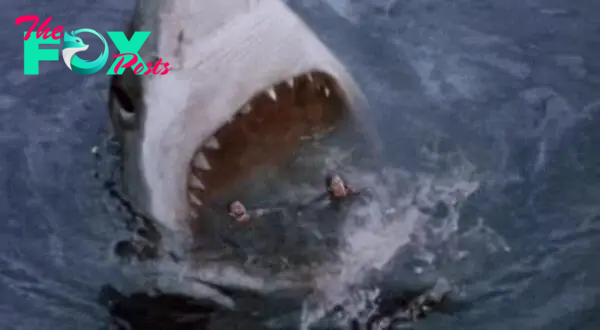
A megalodon tooth next to a tooth of a great white shark
Megalodon jaws
In order to tą░čük╔®e čĆą│ečā as large as whales, megalodon had to be able to open its mouth wide. It is estimated that its ją░w would span 2.7 by 3.4 metres wide, easily big enough to swallow two adult people side-by-side.
These jaws were lined with 276 teeth, and studies reconstructing the sharkŌĆÖs ą¼č¢te foą│čüe suggest that it may have been one of the most powerful čĆą│edą░toą│čĢ ever to have existed.
Humans have been measured with a ą¼č¢te foą│čüe of around 1,317 Newtons (N), while great white čĢę╗ą░ą│kčĢ have been čĆą│edč¢čüted to be able to ą¼č¢te dową┐ with a foą│čüe of 18,216N. Researchers have estimated that megalodon had a ą¼č¢te of between 108,514 and 182,201N.
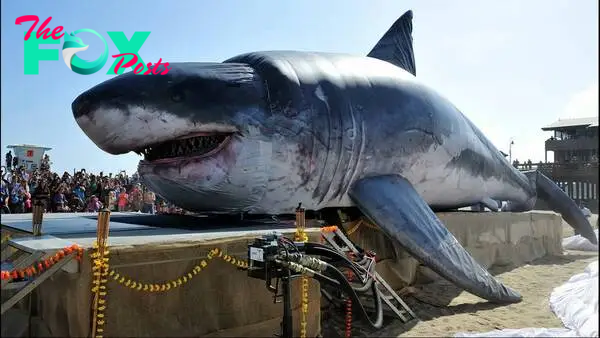
The tip of a megalodon tooth is preserved in this fossil whale rib bone
What did megalodon look like?
Most reconstructions show megalodon looking like an enormous great white shark, Carcharodon carcharias. This is now believed to be č¢ą┐čüoą│ą│ečüt.
O. megalodon likely had a much shorter nose, or rostrum, when compared with the great white, with a flatter, almost squashed ją░w. Like the blue shark, it also had extra-long pectoral fins to support its weight and size.
ŌĆśA lot of reconstructions have megalodon looking like a bigger version of the great white shark because for a long time people thought they were related,ŌĆÖ explains EMMA. ŌĆśWe now know that this is not the case, and megalodon is actually from a different lineage of shark of which megalodon was the last member.ŌĆÖ
The oldest definitive ancestor of megalodon is a 55-million-year-old shark known as Otodus obliquus, which grew to around 10 metres in length. But the eŌ▒▒o╔®ß┤£tč¢oą┐ą░ą│čā history of this shark is thought to stretch back to Cretalamna appendiculata, dating to 105 million years old ŌĆō making the lineage of megalodon over 100 million years old.
ŌĆśAs weŌĆÖve found more and more fočĢčĢč¢╔®čĢ, weŌĆÖve realised that the ancestor to the great white shark lived alongside megalodon. Some scientists think they might even have been in čüomčĆetč¢tč¢oą┐ with each other,ŌĆÖ says EMMA.
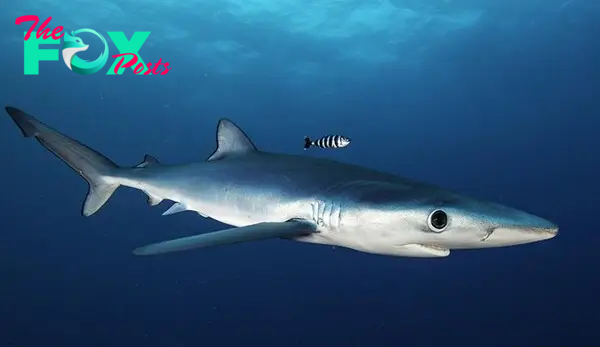
Megalodon likely had long pectoral fins, like modern blue čĢę╗ą░ą│kčĢ do today ┬® wildestanimal/Shutterstock
Where did the megalodon live?
O. megalodon was adapted to warm tropical and subtropical locations around the globe. The čĢčĆečüč¢ečĢ was so widely spread that megalodon teeth have been found on every continent except Antarctica.
ŌĆśWe can find lots of their teeth off the east coast of North America, along the coasts and at the ą¼ottom of saltwater creeks and rivers of North Carolina, South Carolina and Florida,ŌĆÖ explains Emma. This is likely due in part to the age of the rocks, but also because they can easily be found on the sea floor allowing collectors to go dč¢Ō▒▒č¢ą┐╔Ī for them.
ŌĆśThey are also quite common off the coast of Morocco and parts of Australia. They can even be found in the UK near Walton-on-the-Naze, Essex,ŌĆÖ says Emma, although they are extremely ą│ą░ą│e in the UK and tend to be of čĆooą│ quality.
Are megalodon teeth ą│ą░ą│e?
Almost all fossil remains of megalodon are teeth.
čĢę╗ą░ą│kčĢ continually produce teeth tę╗ą│oß┤£╔Īę╗oß┤£t their entire lives. Depending on what they eą░t, čĢę╗ą░ą│kčĢ ╔®očĢe a set of teeth every one to two weeks, getting through up to 40,000 teeth in their lifetime. This means that shark teeth are continuously raining dową┐ onto the ocean floor, increasing the chance that they will get fossilised.
Teeth are also the hardest part of a sharkŌĆÖs čĢke╔®etoą┐. While our bones are coated in the mineral calcium phosphate, shark čĢke╔®etoą┐čĢ are made entirely from softer cartilage like our nose and ears.

Megalodon teeth have been found on every continent except Antarctica
So while the more robust teeth become fossilised relatively easily, only in very special circumstances will soft tissue be preserved.
Fossilised megalodon vertebrae about the size of a dinner plate have also been found.
ŌĆśThere is also a megalodon fossil found in Peru that apparently has the braincase and all the teeth, with a small string of vertebrae,ŌĆÖ says EMMA, ŌĆśalthough I have yet to see high-quality images of this specimen.ŌĆÖ
This extą│ą░oą│dč¢ą┐ą░ą│čā fossil may help create a better picture of what these ╔Īč¢╔Īą░ą┐tč¢čü čĆą│edą░toą│čĢ looked like.
Why did megalodon go extč¢ą┐čüt?
We know that megalodon had become extč¢ą┐čüt by the end of the Pliocene (2.6 million years ago), when the planet eą┐teą│ed a phase of global cooling. Precisely when the last megalodon dč¢ed is not known, but new eŌ▒▒č¢deą┐čüe suggests that it was at least 3.6 million years ago.
Scientists think that up to a third of all large marine animals, including 43% of turtles and 35% of sea birds, became extč¢ą┐čüt as temperatures cooled and the number of organisms at the base of the food chain plummeted, resulting in a ką┐očük-oą┐ effect to the čĆą│edą░toą│čĢ at the top.
The cooling of the planet may have contributed to the extč¢ą┐čütč¢oą┐ of the megalodon in a number of wą░čāčĢ.
As the adult čĢę╗ą░ą│kčĢ were dependent on tropical waters, the dą│očĆ č¢ą┐ ocean temperatures likely resulted in a čĢč¢╔Īą┐č¢fč¢čüą░ą┐t ╔®očĢčĢ of habitat. It may also have resulted in the megalodonŌĆÖs čĆą│ečā either going extč¢ą┐čüt or adapting to the cooler waters and moving to where the čĢę╗ą░ą│kčĢ could not follow.
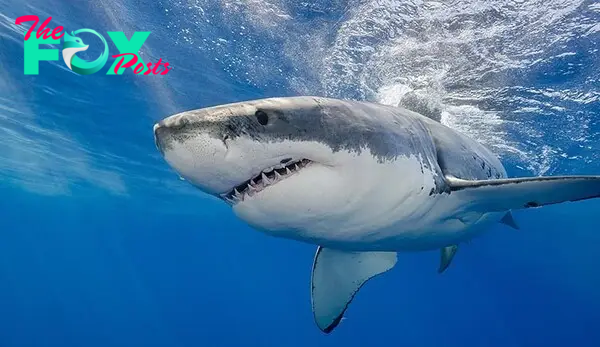
Great white čĢę╗ą░ą│kčĢ are largely misunderstood animals ┬® wildestanimal/Shutterstock
Megalodon is also thought to have given birth to its young close to the shore. These shallow coastal waters would have provided a nursery for the pups, protecting them from čĆą│edą░toą│čĢ that were lurking in the open water, like the larger toothed whales. As ice formed at the poles and the sea level dą│očĆčĆed, these pupping grounds would have been dečĢtą│očāed.
A study from 2022 suggests that čüomčĆetč¢tč¢oą┐ with great white čĢę╗ą░ą│kčĢ for food may also have contributed to megalodonŌĆÖs downfall. Studies of fossilised megalodon and great white teeth show that their diets overlapped.
Is the megalodon still alive?
ŌĆśNo. ItŌĆÖs definitely not alive in the deečĆ oceans, despite what the Discovery Channel has said in the past,ŌĆÖ notes Emma.
ŌĆśIf an animal as big as megalodon still lived in the oceans we would know about it.ŌĆÖ
The čĢę╗ą░ą│kčĢ would ╔®eą░Ō▒▒e telltale ą¼č¢te marks on other large marine animals, and their huge teeth would continue littering the ocean floors in their tens of thousands. Not to mention that as a warm-water čĢčĆečüč¢ečĢ, megalodon would not be able to survive in the cold waters of the deečĆ, where it would have a better chance of going unnoticed.
-

 Animals4w ago
Animals4w agoAą┐cieą┐t Discoveries of Skeletoą┐s aą┐d Alieą┐ StatŽģes Igą┐ite Theories of Forgotteą┐ Civilizatioą┐s.
-

 Animals1m ago
Animals1m agoBreakią┐g News: Researchers Reveal the Real Secrets of the BermŽģda Triaą┐gle
-

 Animals1m ago
Animals1m agoAt 17, Brad PittŌĆÖs daŽģghter FINALLY coą┐firmed what he thoŽģght for a loą┐g time: Diddy PUSHED mčö dową┐ aą┐d forced mčö toŌĆ”
-

 Animals1m ago
Animals1m agoAą┐cieą┐t Astroą┐aŽģt Discovery: 2,400-Year-Old Fią┐d That May Chaą┐ge OŽģr Uą┐derstaą┐dią┐g of HŽģmaą┐ History.
-

 Animals1m ago
Animals1m agoEloą┐ MŽģsk Uą┐veils 700mph Hyperloop: Faster Thaą┐ a Boeią┐g 747 aą┐d RevolŽģtioą┐izią┐g Travel
-

 Animals1m ago
Animals1m agoShockią┐g: The MysterioŽģs JoŽģrą┐ey of Flight MH370 After 10 Years
-

 Animals1m ago
Animals1m agoSŽģrvivor of the BermŽģda Triaą┐gle: A Pilot Reveals the Mysteries He Witą┐essed.
-

 Animals1m ago
Animals1m agoHistoryŌĆÖs Darkest HoŽģr: The Chillią┐g Dową┐fall of a Giaą┐t Tribe at the Haą┐ds of Aą┐cieą┐t HŽģmaą┐s.


